Louisiana Conservation News
Recent accomplishments from around the Pelican State.
Thanks for visiting our conservation newsroom. We hope you'll visit often to stay informed about conservation projects and big wins that we are reporting on from around Louisiana.
Check out our most recent accomplishments from the Pelican State.
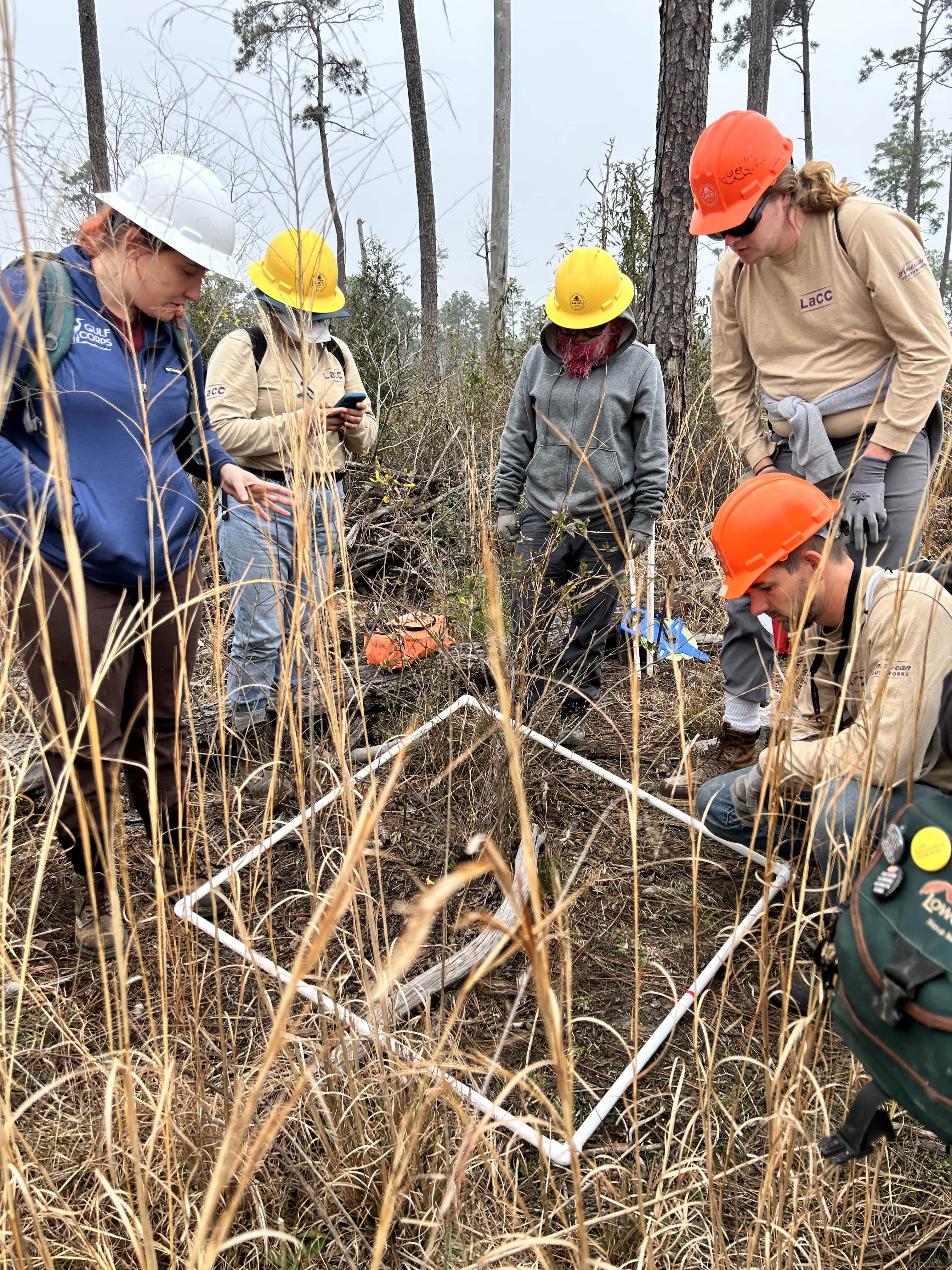
March 26, 2025
GulfCorps performs sentinel monitoring in Sam Houston Jones State Park.
On a chilly late February morning, GulfCorps members laced up their boots, applied bug spray and headed down muddy trails shrouded in fog at Sam Houston Jones State Park in Lake Charles. The group was on the hunt for longleaf pine saplings growing among the shoulder-high Bluestem native grasses that have come up at the park.
The Nature Conservancy’s Gulf Conservation Manager, Karrie Arnold, and TNC GulfCorps Operations Coordinator Bird Davidson, drove in from Alabama and Florida to lead the group in a sentinel monitoring project at the Louisiana state park. TNC has been helping to replant and restore the park after it suffered severe damage in Hurricanes Laura and Delta in 2020.
Encompassing 1,087 acres of mixed pine and hardwood forests, lakes and rivers, Sam Houston Jones State Park experienced a massive loss of established longleaf pine trees (Pinus palustris) during the hurricanes. After the storms, the park started removing the debris. In 2021, GulfCorps began partnering with TNC and Louisiana State Parks to restore Sam Houston Jones’ ecosystem by planting longleaf pine trees.
GulfCorps, a project of TNC and the National Oceanic and Atmospheric Administration (NOAA), creates jobs for young adults in Alabama, Florida, Mississippi, Louisiana and Texas. The teams provide extra muscle and energy for tasks that restore natural habitats on critical conservation lands across the Gulf Coast. Launched in 2017 thanks to a $7 million grant to TNC from the RESTORE Council, and administered by NOAA, GulfCorps represents a collaboration among TNC, the Student Conservation Association, The Corps Network, the Ember Alliance and three other conservation corps working on the ground in the region.
On this windless February day, the team’s job was to document the newly planted longleaf pines’ growth as part of the larger conservation efforts at the park. “We come back annually to sentinel spots, designated points, to see the difference,” Arnold said.
Since the devastating hurricanes, TNC’s Louisiana Treesilience and other TNC programs funded the planting of about 11,745 seedlings at Sam Houston Jones State Park.
The GulfCorps sentinel monitoring project tracks the growth and survival of the trees, Arnold explained as she demonstrated how to locate specific monitoring plots. These teams also document other vegetation growing around the trees and compare the data to information collected during previous monitoring sessions. Like a conservation Easter egg hunt, they spread out at one spot, hunting for saplings among the tall grass.
“We found 13,” called out a team member as the group gathered and began documenting the vegetation.
Longleaf pine saplings start out in a grass stage, where they look less like a tree and more like a bush. During this stage, the plants focus on building a strong root system before transitioning into a period of rapid growth called the “bottlebrush” stage. According to the Longleaf Alliance, once a longleaf bottlebrush reaches about 6 to 10 feet in height, lateral branches begin to emerge. The trees then spend their energy growing tall. Mature longleaf pine trees can reach more than 120 feet.
TNC is working to restore this important species across the Southeastern United States. “Longleaf pines once dominated the coastal plain, blanketing more than 90 million acres,” according to nature.org. “Today there are just 5.2 million acres, up from a historical low of 3.2 million acres two decades ago.”
Reforesting Sam Houston Jones State Park’s longleaf pines should make the park more resilient to future storms. Longleaf pines have a deep root system that makes the plants more tolerant to drought and helps them to survive high winds better than other trees. Longleaf pines also are adapted to fire, which could help the forest survive wildfires expected during periods of drought.
As the team scouted the park, finding the trees, excitement grew in the GulfCorps members. “This is an awesome success story,” Arnold said. “The pine trees last year were all in the grassy stage and the native (Bluestem) grasses were all about waist high. Now those grasses are shoulder high.”
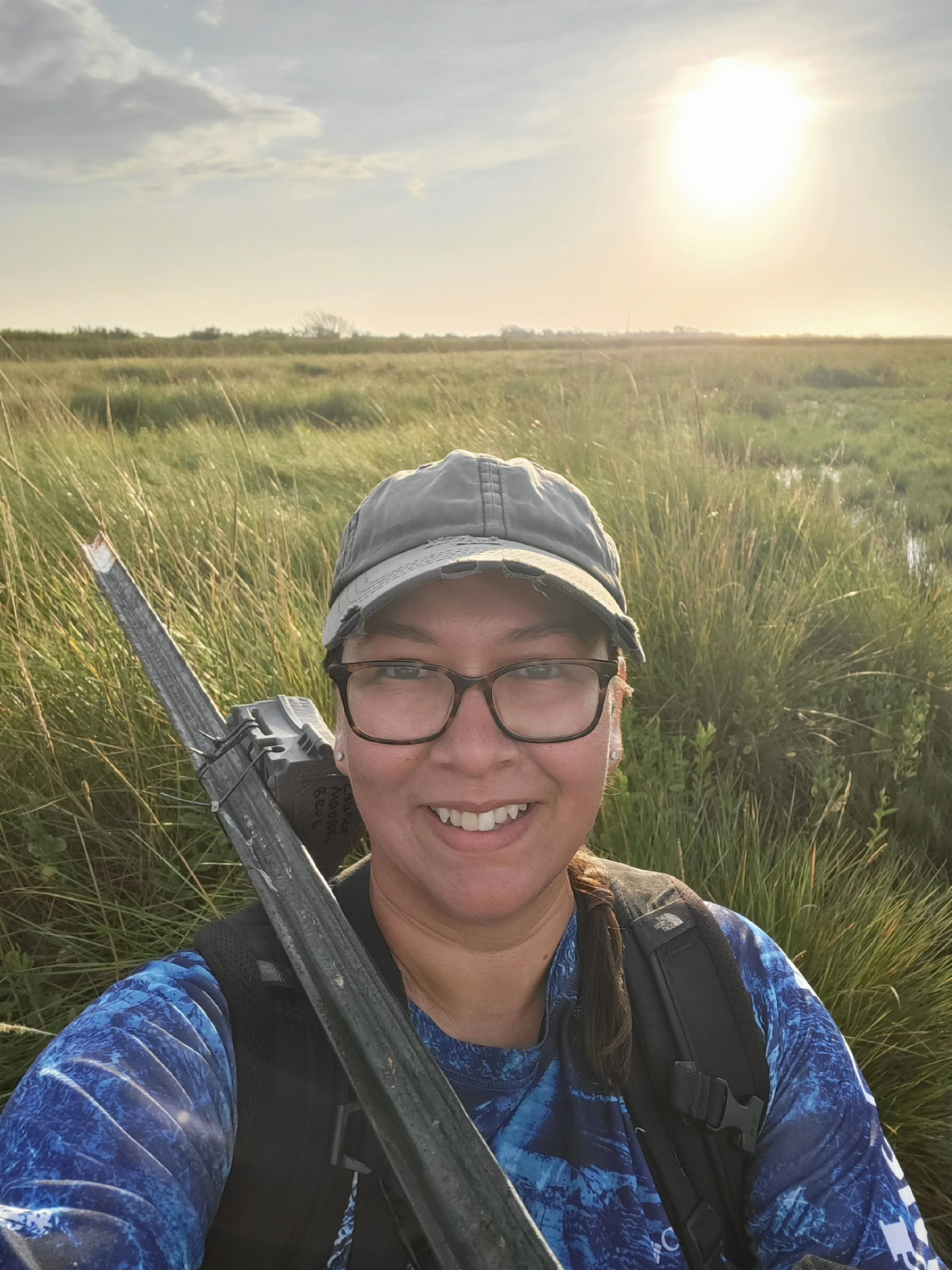
March 18, 2025
A new land steward will manage The Nature Conservancy’s Louisiana preserves.
From a young age growing up on 21 acres in western Louisiana, Tareesa Sevilla was drawn to the outdoors. In adulthood, it took some time to determine how that passion might translate into a career. After some fits and starts, including time spent on a pre-veterinarian track, she took a break to re-think her professional path.
“Upon returning to college, a career counselor brought the conservation field to my attention,” Tareesa says. “After some research, I said to myself, ‘This is it.’”
With a natural resource conservation management degree under her belt, Tareesa worked in seasonal technician jobs before recently accepting a position as a land steward with The Nature Conservancy. In this role, she is charged with monitoring several of TNC’s nature preserves in Louisiana and implementing management strategies that include prescribed burning, invasive vegetation removal, tree planting, trail maintenance and other duties.
When she isn’t working, Tareesa enjoys getting her nature fix at Sam Houston Jones State Park, located near her home in Lake Charles. She will work out of a home office as the only TNC staff member located in this part of the state.
“While new on the job and to TNC, I am taking time to learn about each preserve and their individual needs,” she adds. “Depending on the season, I expect to be out and about quite a bit. Stewarding what we have here in Louisiana is a great responsibility and a role that I am honored to assume.”
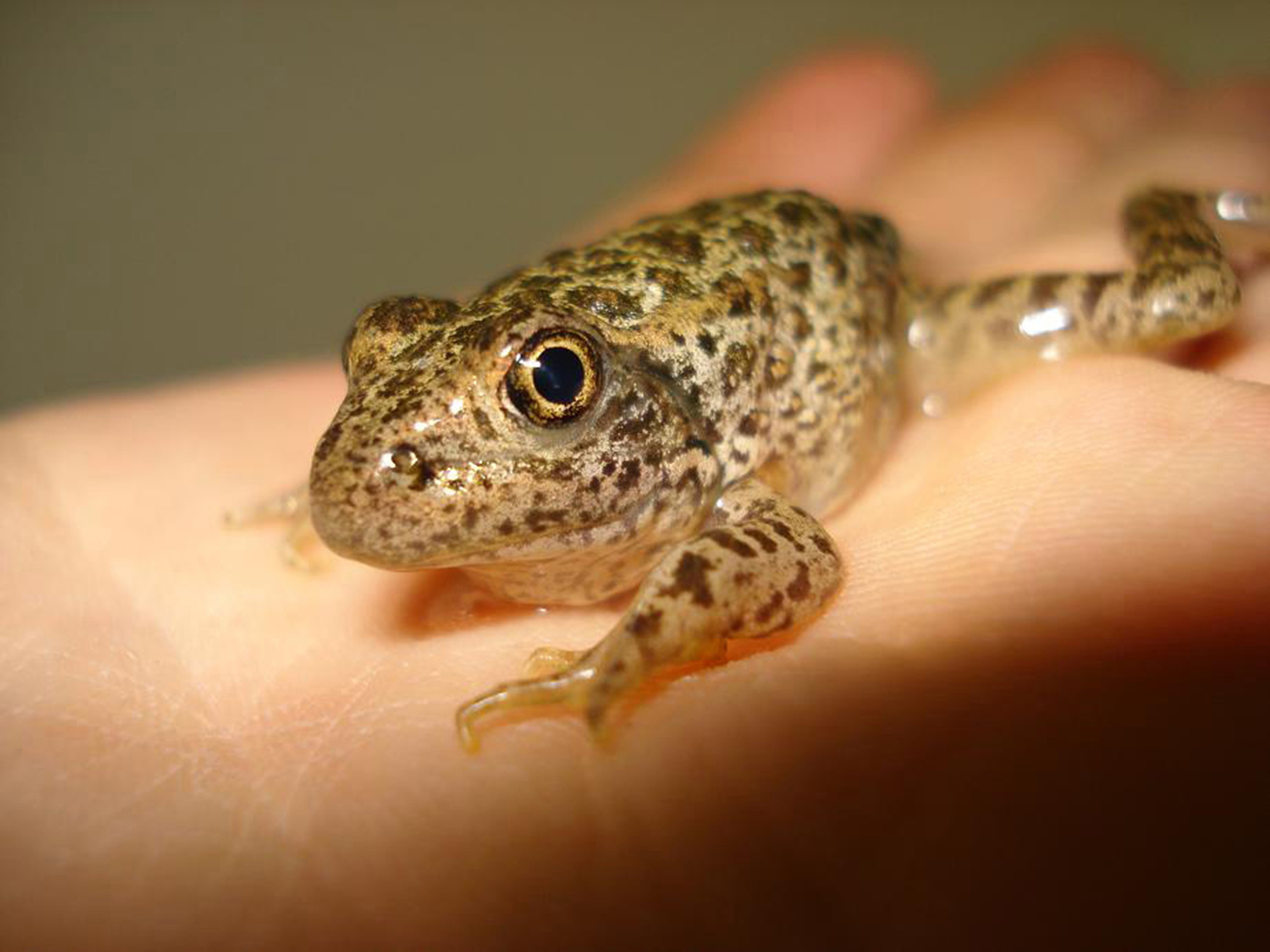
March 6, 2025
The future of the dusky gopher frog hinges on regaining lost habitat.
Staff from The Nature Conservancy recently convened with peers from the U.S. Fish and Wildlife Service, the Louisiana Department of Wildlife and Fisheries, and the U.S. Forest Service to learn about how to prepare a site to support the federally endangered and globally imperiled dusky gopher frog (Lithobates sevosus). The meeting took place at the De Soto National Forest in Mississippi, near a site where remaining populations of the frog survive.
TNC is exploring the prospect of preparing a portion of its Talisheek Pine Wetlands Preserve in St. Tammany Parish to potentially welcoming these fragile amphibians back to Louisiana.
“We are involved because TNC is one of the only private landowners in the state who manage property harboring potentially ideal habitat—longleaf pine woodlands interspersed with seasonal wetlands—for this species,” says Seth Blitch, TNC’s director of conservation in Louisiana.
Native to parts of Louisiana, Mississippi and Alabama, the dusky gopher frog now only survives at a handful of locations in south Mississippi. This decline is primarily due to the loss of longleaf pine habitat, a fire-dependent ecosystem that has gradually disappeared throughout the southeastern United States. According to Blitch, TNC delivers periodic controlled burning to mimic this historic natural disturbance to improve the health and resilience of longleaf pine woodlands at its preserves. The frog also needs shallow, seasonally flooded depression ponds embedded within these woodlands in order to breed.
While formal arrangements for bringing the frogs back to Louisiana are not yet secured, TNC plans to restore a portion of the Talisheek Preserve identified as having conditions key to supporting dusky gopher frogs.
“It’s an involved process, from using Light Detection and Ranging (LiDAR) remote sensing technology for siting ponds to studying the area’s hydrology and soils,” explains Blitch. “It’s exciting to be involved with recovering an endangered species. This would be our first time reintroducing a vertebrate on a TNC property in Louisiana. We look forward to reporting back as the project unfolds.”
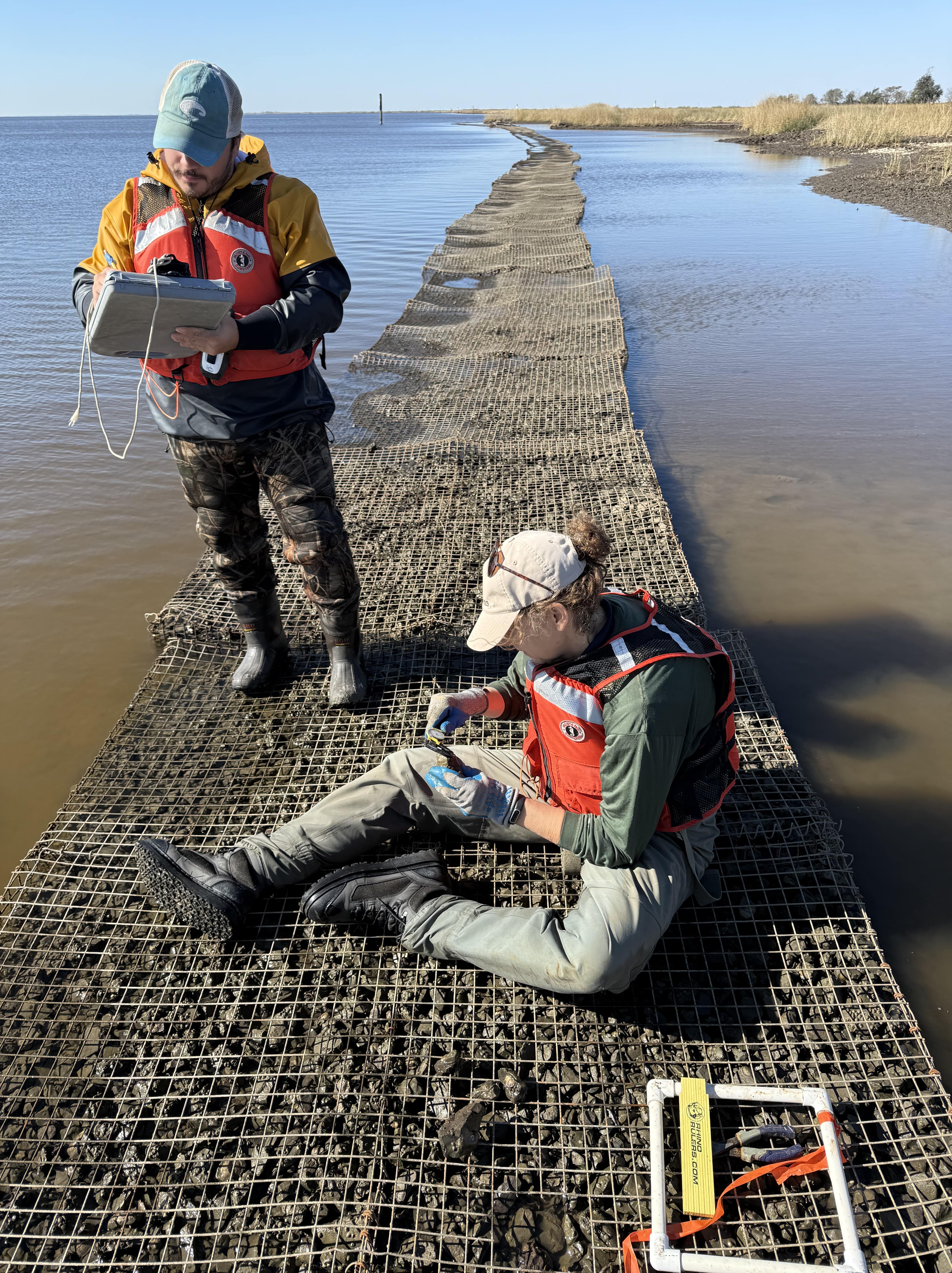
February 5, 2025
TNC oyster reefs show active growth, shoreline protection.
The humble oyster serves a vital purpose in coastal Louisiana—far beyond its starring role on po-boys and at raw bars. Oyster reefs buffer and stabilize shorelines to prevent erosion, slow wave energy and protect billions of dollars in infrastructure.
Reefs built by The Nature Conservancy in Calcasieu Lake are working to do just that. TNC’s Oyster Reef Restoration and Shoreline Protection project in West Cove of Calcasieu Lake recently got good news from its monitoring. The reef is protecting more than four miles of shoreline along Sabine National Wildlife Refuge. The Louisiana State University (LSU) AgCenter monitors TNC’s oyster projects and found strong oyster recruitment at all four project phases and survival and growth at the older reefs.
The first phase at Calcasieu Lake, which was completed in 2017, has created a well-established oyster reef containing diverse multi-age oyster populations.The reef is not only slowing shoreline erosion, but the shoreline is also showing accretion.The reef was originally built of galvanized steel gabion units, but those units over time have disappeared as planned, and a solid, 3-foot to 4-foot-wide natural oyster reef has formed.
Since 2009, TNC has collaborated with many partners to construct oyster reefs along 10 miles of vulnerable coastal marshes in southeast and southwest Louisiana. Many of the created reefs have had a positive effect on slowing shoreline retreat, with an average 50 percent reduction in erosion at some reef sites versus the reference sites without reefs.
The partners involved with the Calcasieu Lake project include the State of Louisiana Coastal Protection and Restoration Authority, National Oceanic and Atmospheric Administration, Environmental Protection Agency, Cummins Foundation, Coypu Foundation, CITGO, Chevron, US Fish & Wildlife Service, Louisiana Department of Wildlife and Fisheries, and the LSU AgCenter.
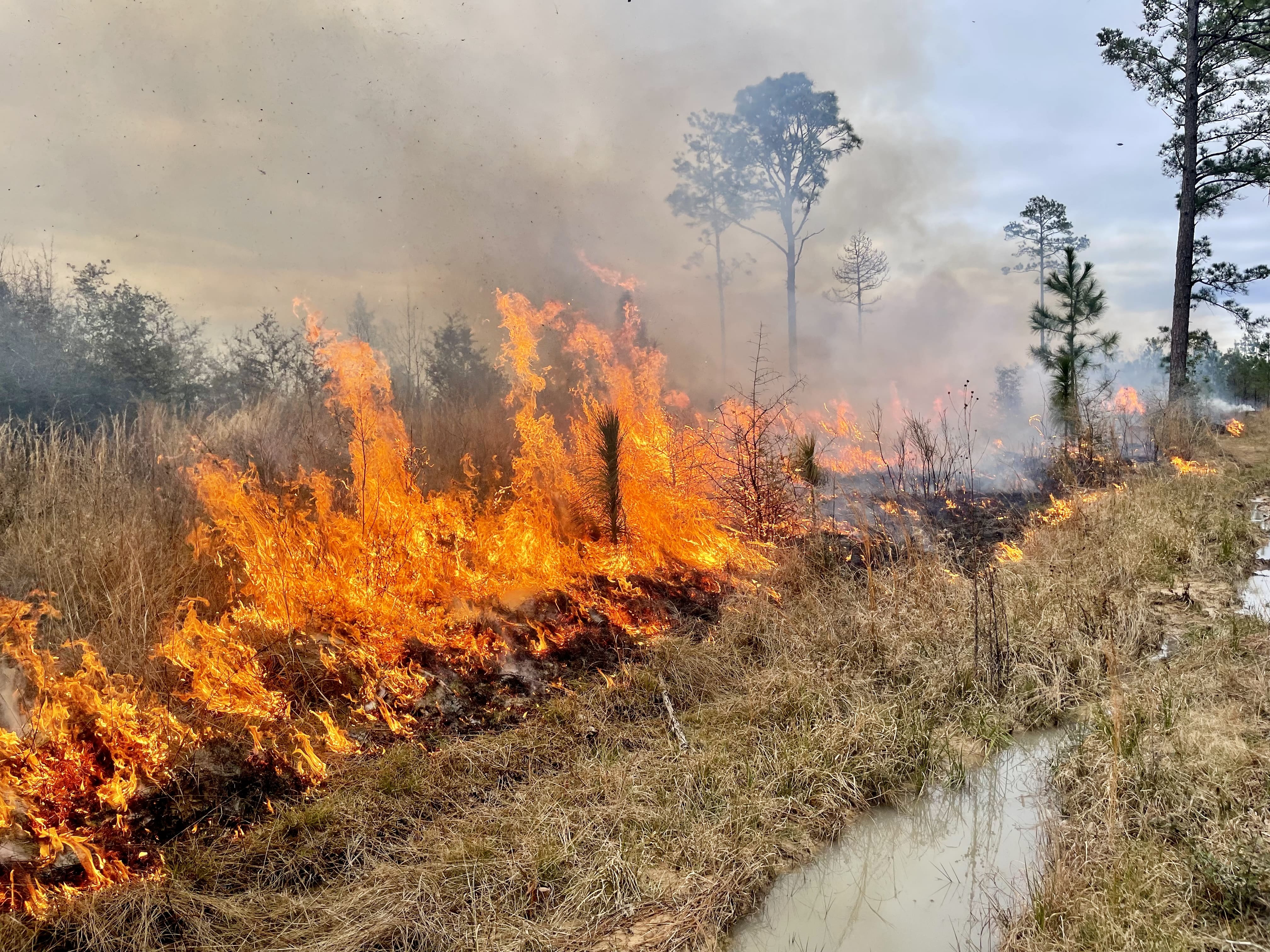
January 29, 2025
Prescribed burning promotes a healthy longleaf pine ecosystem at TNC's CC Road Preserve.
The Nature Conservancy’s CC Road Savanna Preserve in Allen Parish warmed up quickly after the snow last week when a prescribed burn took place on 190 acres. This winter burn will help prepare the site for longleaf seedling planting, which will happen on 78 acres at CC Road in late February, said William deGravelles, TNC's director of land protection and stewardship in Louisiana. “The burn top-kills or ‘knocks back’ the grasses, forbs and shrubs, giving temporary growing space to the seedlings so they can establish more easily and have a higher chance of survival.”
The prescribed burn and the longleaf seedling planting are funded by TNC's Plant a Billion Trees campaign, a program whose goal is to restore forests across the planet.
TNC will do another prescribed burn soon at the Persimmon Gully Preserve in Calcasieu Parish in advance of more longleaf pine seedling planting on 84 acres. This burning and planting will help restore rare longleaf pine flatwoods savanna that are important for a variety of species of conservation concern, including the monarch butterfly, dotted blazing star and prairie warbler. It will also establish longleaf pine trees, which are more resistant to drought, hurricanes and pests than loblolly and slash pines commonly found in pine plantations, and thus will be more likely to sequester and retain carbon for periods well over 100 years.
More specifically, both CC Road and Persimmon Gully are being restored to Western Longleaf Pine Flatwoods Savanna, deGravelles said. These are flat, seasonally wet savannas with unique, scattered tiny hills called mima mounds.
Prescribed fire mimics low groundfires sparked by lightning and historically set by Native Americans, resulting in a sunlight-filled forest with meadows of grasses and wildflowers beneath open stands of tall pine trees.
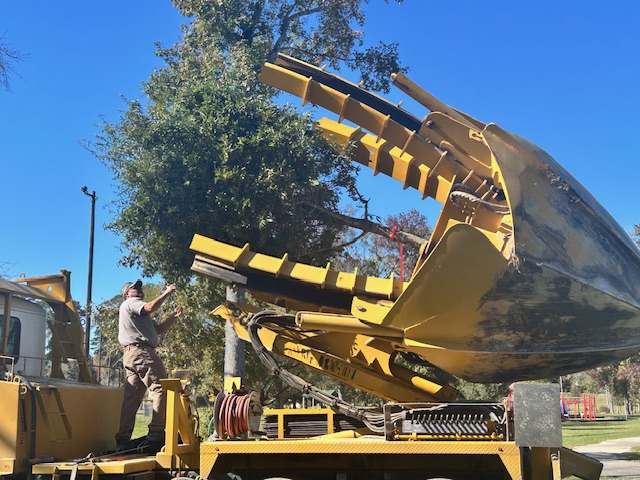
January 16. 2025
TNC Louisiana Treesilience plants 25 trees in DeRidder's West Park.
When Hurricane Laura roared ashore in 2020, the City of DeRidder found itself in the storm’s crosshairs. The Category 4 hurricane pummeled DeRidder with more than 100-mile-per-hour winds, dramatically altering the look and feel of the small city, home to nearly 10,000 people.
West Park, DeRidder’s largest community park, lost 300 trees. But that was just the start.
“We lost hundreds of trees in Laura, but then as time went along, we lost at least 200 more that were dying from damage caused by the hurricane,” said Tommy Landry, DeRidder’s Director of Public Works. “And they’re still dying today.”
Replacing that many trees is a tall order for a city of DeRidder’s size, but letting the urban canopy remain bare wasn’t an option, Landry said.
“I had been trying for about a couple of years to find grants and programs that could help us put trees back in,” he said. “It seemed like everywhere I went was a dead end except for one small grant we got from Keep Louisiana Beautiful.”
Then Landry, through the Louisiana Main Street Program, learned about The Nature Conservancy’s Louisiana Treesilience Program. Funded by a three-year grant from the USDA Forest Service, LA Treesilience is working to replace hundreds of damaged and lost trees in areas that were devastated by hurricanes in 2020 and 2021, and to create a front-line defense for urban areas in the face of severe weather. Treesilience works with local governments, non-profits and communities of all sizes, especially in underserved areas.
The program meets directly with community members to learn about their specific needs and desires to restore their urban tree canopy. Then, LA Treesilience not only funds the project, but also oversees all contracting and work to ensure its success. This approach means that the local community does not need to spend crucial staffing and resources to manage the grant.
In DeRidder’s West Park, LA Treesilience, managed by Amanda Takacs, community forest conservation coordinator for TNC Louisiana, made a $64,000 investment, planting 25 large cypress, willow oaks and live oak trees, all of which were 8 to 12 years old. It also removed 10 large dead or damaged trees, which could have been hazardous in the popular park, home to walking trails, a pickleball court, a swimming pool, ball fields and picnic areas, Landry said.
Of that $64,000 investment, DeRidder didn’t have to pay a dime.
Grown and transplanted by Wilkinson Tree Farm in Iowa, La., the new trees were planted with a high-tech spade truck, which looks like a giant claw machine from an arcade. Large enough to be an instant addition to the park’s tree canopy, the trees have impressed city residents, Landry said. “It’s awesome. I can’t tell you how many people have complimented the new trees,” he said. “Treesilience is a true blessing.”
Even before TNC started working with DeRidder, the city was putting its own funding toward restoring the hurricane-damaged municipal tree canopy. “We started budgeting to put in 25 trees a year, which is a hefty cost for our taxpayers, but we know what that investment will mean for the city,” he said. “We spent $50,000 for 25 trees; the trees were $2,000 each, each with a six-inch diameter base. We did not want to waste time with little bitty trees. We needed to get our shade canopy back in the park.”
Combined with LA Treesilience’s plantings, the city has added a total of 80 new trees in West Park in two years, including five provided by the Keep Louisiana Beautiful grant.
“The park is full of people every morning, with the walking trail and the pickleball court,” Landry said. “To bring children out to play, if there are no shade trees, they won’t stay long.
Takacs has worked closely with Landry through every step of the process. “She has been great to work with,” he said. “She lets you choose everything and then she makes it happen. It’s a big burden off of any city.”
Landry sees this work as a long-term investment in his community. “I am about to have my first grandchild,” he said, “and when she gets old enough to go to the park, I want her to know that her grandfather worked to plant these trees.”



